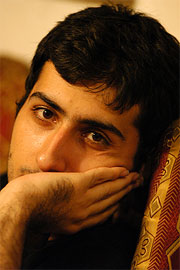 |
"Hail! You Wandering Butterflies"
May 2007
|
 |
|
This year for Moharram [the first month of the Islamic calendar], I went to the Iranian city of Khorramabad, the capital of Lorestan province, for the second time [see "The Soil Dance" in TDJ, April 2006: http://digitaljournalist.org/issue0604/dis_shirjian.html]. This province, according to the findings of archeological studies, is considered one of the oldest habitats of mankind. Lorestan province comprises 28,392 square kilometers of Iran's 1,648,195 square kilometers and has a population of 1,760,000.

Women in Khorramabad, Iran, silently go from house to house lighting 40 candles during the Islamic mourning ceremony known as "Chehel Menbar" (Forty Pulpits). To ensure that they don't lose each other in the huge crowd, the women knot their chadors together.
On this day the mourning ceremonies performed in each city of Iran differ according to the regional cultures. The Chehel Menbar ceremony in Khorramabad starts at 9 o'clock in the morning and continues until the dark of the day. Women perform this ritual but men can watch it nearby.

A woman from Khorramabad, Iran, shields her ceremonial candle with her shoes to protect it from the wind.
They do not talk to each other and remain silent throughout the program. They remove their shoes and remain barefoot during this day. Those women whose wishes have been fulfilled during the previous year bring cookies and offer them at the houses where they lit candles the year before.
I asked the women about the philosophy behind these rituals and they said: "A candle symbolizes the development of spiritual perfection in an individual; in fact, in the course of lighting up the 40 candles and uttering Zekr (talking to God), we light up our inner candles.

The women of Khorramabad, Iran, participate in “Chehel Menbar” ceremony. This event takes place every year during the Moslem observation of Ashura in commemoration of the martyrdom of Imam Hussein and Hazrate Abolfazl.
The people of Khorramabad welcomed the photographers because they wanted "Chehel Menbar" to be presented and recognized.
In Iran most ceremonies performed by women do not allow men to attend because the women are bareheaded (without Hijab), but it is not so in this event.
When I told the people in Khorramabad that I intended to write a report for The Digital Journalist, there were two different types of response: some were all for it and some were completely against it. The women who were against it said, "We cover our faces willingly for this religious ceremony but we don't want to imply that women in Iran appear this way everyday and have limited choices."
I promised that I would reflect their views. I also said that the photojournalists are like butterflies; they touch the flowers (the people) and take the sweetness and through the photographers' migration from one flower to another they help promote understanding--just as the butterflies help with the reproduction of flowers.
Hearing this, one woman asked me to say for her, "Hail! You wandering butterflies."
I think the cultures are like trees; each one has roots in a different soil but the fruit is the same for all.
© Ali Akbar Shirjian
Dispatches are brought to you by Canon.
|
|
Back to May 2007 Contents
|
|